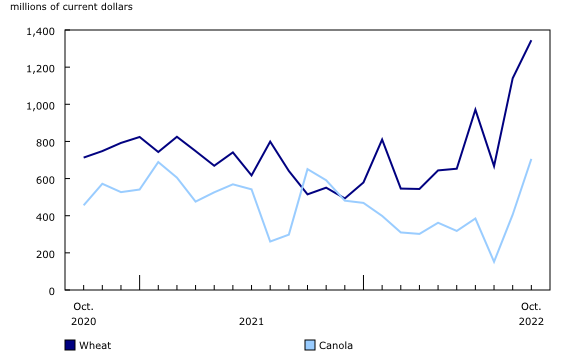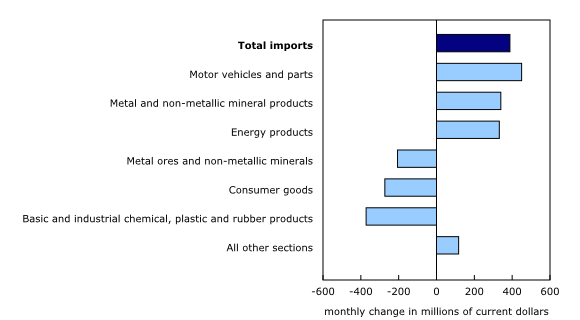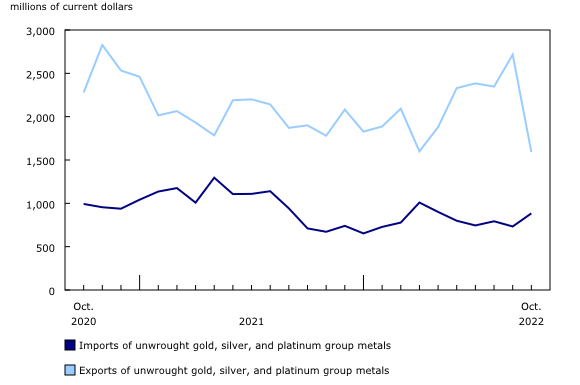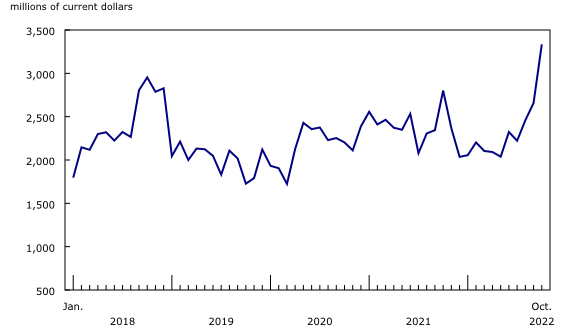Canadian international merchandise trade, October 2022
Released: 2022-12-06
In October, Canada's merchandise exports rose 1.5%, while imports increased 0.6%. As a result, Canada's merchandise trade surplus with the world widened from $607 million in September to $1.2 billion in October.
Consult the "International trade monthly interactive dashboard" to explore the most recent results of Canada's international trade in an interactive format.
Depreciation of the Canadian dollar impacts both imports and exports in October
A large proportion of import and export transactions are completed in US dollars and must be converted to Canadian dollars to compile monthly trade statistics. When the Canadian dollar depreciates against the US dollar, converted monthly trade values in Canadian dollars are higher.
In October, the average value of the Canadian dollar decreased 2.1 cents US compared with the average value in September, falling to 73.0 cents US, its lowest level since May 2020. When expressed in US dollars, Canadian exports were down 1.3% in October, and imports decreased 2.2%.
The value of the Canadian dollar rose 1.4 cents US in November, which will have a downward effect on trade values for that reference month.
Exports of consumer goods and farm products increase the most in October
Total exports rose 1.5% to $67.0 billion in October. Gains were observed in 8 of the 11 product sections. In real (or volume) terms, total exports edged up 0.1% in October, while export prices rose for the first time in five months.
Exports of consumer goods (+9.7%) were the largest contributor to the overall increase in exports in October. Pharmaceutical products (+20.7%) contributed the most to the gain, led by higher exports of medicinal products to the United States. After falling 36.7% from June to September, exports of miscellaneous goods and supplies rebounded in October (+ 30.7%), mainly on higher exports of gold bars and coins to the United States.
For a second consecutive month, exports of farm, fishing and intermediate food products rose sharply, increasing 10.2% in October to a record-high $5.5 billion. Exports of canola (+73.8%) and wheat (+18.0%) were once again mainly responsible for the increase. Owing to elevated production in the most recent crop year, larger quantities of wheat and canola became available for export. This comes amid strong global demand and high prices for these products.
Exports of aircraft and other transportation equipment and parts advanced 17.5% to $2.4 billion in October, the highest level observed since January 2021. Aircraft exports were the main contributor to the growth, led by higher exports of private jets and commercial airliners to the United States.
After falling 9.3% in September, exports of metal ores and non-metallic minerals increased 13.0% to a record-high $3.1 billion in October. Potash exports (+15.4%) were largely responsible for the monthly variations in this product section for the past two months. In October, significant growth in exports of potash to Bangladesh was observed. Challenging weather conditions for farmers abroad and the conflict in Ukraine have contributed to the recent increase in global demand for Canadian fertilizers. Compared with October 2021, Canadian potash exports have more than doubled.
Lower exports of metal and non-metallic mineral products (-15.0%) offset much of the gain in exports in October. Exports of unwrought gold, silver and platinum group metals (-41.4%) were mostly responsible for the decrease in October, led by a decline in gold asset transfers and deliveries of refined gold to the United Kingdom, Hong Kong and Switzerland. Exports of unwrought gold, silver and platinum group metals had previously risen by almost 70% from April to September.
Offsetting movements in imports
Total imports were up 0.6% to $65.8 billion in October, with increases observed in 6 of the 11 product sections. However, in real (or volume) terms, total imports decreased 0.9%, a second consecutive monthly decline.
Imports of motor vehicles and parts (+4.6%) posted the largest increase in October, driven by higher imports of passenger cars and light trucks (+6.3%). In October, higher imports of light trucks from the United States were observed. The decline in the exchange rate also contributed to the higher import values for passenger cars and light trucks in October.
Imports of metal and non-metallic mineral products rose 6.5% in October. The largest increase was observed in imports of unwrought gold, silver and platinum group metals (+20.6%), mainly because of higher transfers of gold assets from the United States. Imports of nickel also contributed to the growth, owing to high value shipments from Finland that took place in the month.
After posting an 18.8% decrease in September, imports of energy products were up 8.4% in October. Crude oil imports (+9.4%) posted their first gain since June, driven by increased deliveries from the United States. Imports of refined petroleum products (+8.1%) also rose in October, due in part to higher imports of aviation fuel from India and the United States.
Many product sections also posted considerable declines in October, thereby partially offsetting these increases. They included imports of basic and industrial chemical, plastic and rubber products (-6.4%), consumer goods (-2.0%), metal ores and non-metallic minerals (-12.5%), and electronic and electrical equipment and parts (-2.6%).
Exports to China reach a record high
Exports to countries other than the United States increased 2.2% in October, led by higher exports to China, South Korea and Italy. Exports to China sharply increased by 25.4% to a record-high $3.3 billion, driven by higher exports of canola, oilseeds and wheat. Lower exports to the United Kingdom and Hong Kong offset a large part of these gains, primarily because of a decline in gold deliveries to these countries.
In October, imports from countries other than the United States were up 1.8%. The strongest increases were observed in imports from Belgium (pharmaceutical products) and South Korea (various products). Meanwhile, imports from China (various products) fell 3.7%.
Canada's trade deficit with countries other than the United States widened slightly from $8.7 billion in September to $8.8 billion in October.
Exports to the United States increased 1.3% in October, while imports from that country edged down 0.1%. As a result, after four consecutive monthly decreases, the merchandise trade surplus with the United States widened from $9.3 billion in September to $10.0 billion in October.
Revisions to September merchandise export and import data
Imports in September, originally reported at $65.2 billion in the previous release, were revised to $65.4 billion in the release for the current reference month. Exports in September, originally reported at $66.4 billion in the previous release, were revised to $66.0 billion in the current reference month's release.
Monthly trade in services
In October, monthly service exports were up 1.6% to $13.9 billion. Meanwhile, service imports rose 2.0% to $15.8 billion.
When international trade in goods and services were combined, exports increased 1.5% to $80.9 billion in October, while imports were up 0.9% to $81.7 billion. As a result, Canada's trade deficit with the world went from $1.2 billion in September to $726 million in October.
Note to readers
Merchandise trade is one component of Canada's international balance of payments (BOP), which also includes trade in services, investment income, current transfers, and capital and financial flows.
International trade data by commodity are available on both a BOP and a customs basis. International trade data by country are available on a customs basis for all countries and on a BOP basis for Canada's 27 principal trading partners (PTPs). The list of PTPs is based on their annual share of total merchandise trade—imports and exports—with Canada in 2012. BOP data are derived from customs data by adjusting for factors such as valuation, coverage, timing, and residency. These adjustments are made to conform to the concepts and definitions of the Canadian System of National Accounts.
For a conceptual analysis of BOP-based data versus customs-based data, see "Balance of Payments trade in goods at Statistics Canada: Expanding geographic detail to 27 principal trading partners."
For more information on these and other macroeconomic concepts, see the Methodological Guide: Canadian System of Macroeconomic Accounts (13-607-X) and the User Guide: Canadian System of Macroeconomic Accounts (13-606-G).
The data in this release are on a BOP basis and are seasonally adjusted. Unless otherwise stated, values are expressed in nominal terms, or current dollars. References to prices are based on aggregate Paasche (current-weighted) price indexes (2012=100). Movements within aggregate Paasche prices can be influenced by changes in the share of values traded for specific goods, with sudden shifts in trading patterns—as observed currently with the COVID-19 pandemic—sometimes resulting in large movements in Paasche price indexes. Volumes, or constant dollars, are calculated using the Laspeyres formula (2012=100), unless otherwise stated.
For information on seasonal adjustment, see Seasonally adjusted data – Frequently asked questions.
Revisions
In general, merchandise trade data are revised on an ongoing basis for each month of the current year. Current-year revisions are reflected in both the customs-based and the BOP-based data.
The previous year's customs-based data are revised with the release of data for the January and February reference months, and thereafter on a quarterly basis. The previous two years of customs-based data are revised annually, and revisions are released in February with the December reference month.
The previous year's BOP-based data are revised with the release of data for the January, February, March and April reference months. To remain consistent with the Canadian System of Macroeconomic Accounts, revisions to BOP-based data for previous years are released annually in December with the October reference month.
Factors influencing revisions include the late receipt of import and export documentation, incorrect information on customs forms, the replacement of estimates produced for the energy section with actual figures, changes in merchandise classification based on more current information, and changes to seasonal adjustment factors. The seasonal adjustment parameters are reviewed and updated annually and applied with the October reference month release.
For information on data revisions for exports of energy products, see Methodology for Exports of Energy Products within the International Merchandise Trade Program.
Revised data are available in the appropriate tables.
Real-time data table
The real-time data table 12-10-0120-01 will be updated on December 19.
Next release
Data on Canadian international merchandise trade for November 2022 will be released on January 5, 2023.
Products
The product "International trade monthly interactive dashboard" (71-607-X) is now available. This new interactive dashboard is a comprehensive analytical tool that presents monthly changes in Canada's international merchandise trade data on a balance-of-payments basis, fully supporting the information presented every month in the Daily release.
The product "The International Trade Explorer" (71-607-X) is now available online.
The Canadian International Merchandise Trade online database is no longer available. It has been replaced by the Canadian International Merchandise Trade Web Application (71-607-X), a modern tool that provides trade data users with a number of enhancements.
The updated "Canada and the World Statistics Hub" (13-609-X) is now available online. This product illustrates the nature and extent of Canada's economic and financial relationship with the world using interactive charts and tables. It provides easy access to information on trade, investment, employment and travel between Canada and a number of countries, including the United States, the United Kingdom, Mexico, China, Japan, Belgium, Italy, the Netherlands and Spain.
Contact information
For more information, or to enquire about the concepts, methods or data quality of this release, contact us (toll-free 1-800-263-1136; 514-283-8300; infostats@statcan.gc.ca) or Media Relations (statcan.mediahotline-ligneinfomedias.statcan@statcan.gc.ca).
- Date modified:









